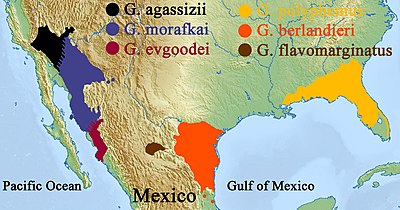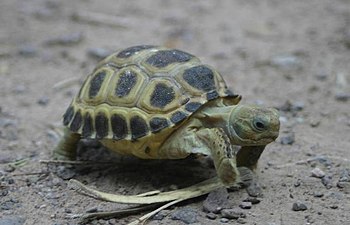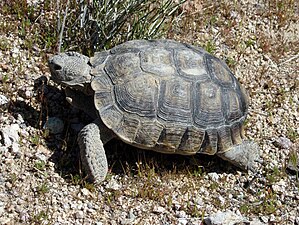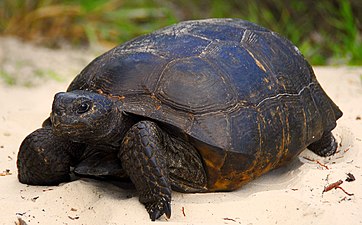Gopherus
| Gopherus Temporal range:
| |
|---|---|

| |
| Gopher tortoise, Gopherus polyphemus
| |
| Scientific classification | |
| Domain: | Eukaryota |
| Kingdom: | Animalia |
| Phylum: | Chordata |
| Class: | Reptilia |
| Order: | Testudines |
| Suborder: | Cryptodira |
| Superfamily: | Testudinoidea |
| Family: | Testudinidae |
| Genus: | Gopherus Rafinesque , 1832
|
| Species | |
| |
Gopherus is a genus of fossorial tortoises commonly referred to as gopher tortoises. The gopher tortoise is grouped with land tortoises that originated 60 million years ago, in North America. A genetic study has shown that their closest relatives are in the Asian genus Manouria.[1] The gopher tortoises live in the
Species
In July 2011, researchers decided on the basis of DNA, and morphological and behavioral data that the Sonoran and Mojave populations of the desert tortoise, G. agassizii were distinct species.[6] This newly described species was named G. morafkai, or the Morafka's desert tortoise. The acceptance of G. morafkai reduced the range of G. agassizii by about 70%[7] In 2016, based on a large-scale genetic analysis, ecological and morphological data, researchers proposed a split between the Sonoran and Sinaloan populations.[8] This southernmost member of the Gopherus genus was named G. evgoodei.[8] As such, there are currently six recognized species in the genus Gopherus:
Extant
Listed alphabetically by binomial name:[9]
| Image | Common Name | Scientific name | Distribution |
|---|---|---|---|
 |
Mojave desert tortoise or Agassiz's desert tortoise | Gopherus agassizii (Cooper , 1863) |
Endemic to USA. Mojave Desert in southeastern California, southern Nevada, and extreme southwestern Utah and northwest Arizona, north and west of the Colorado River.[10]: 3–4 p. |
 |
Texas tortoise | Gopherus berlandieri (Agassiz , 1857) |
Tamaulipan mezquital ecoregion of south Texas, USA, eastern Coahuila, northern Nuevo León, and Tamaulipas, Mexico with a few old records (questionable) from southern San Luis Potosí.[11]: 25 & 27p. |
 |
Sinaloan desert tortoise or Goode's desert tortoise | Gopherus evgoodei Edwards et al., 2016[8] |
Endemic to Mexico. Tropical deciduous forest and thornscrub in southern Sonora and adjacent areas of extreme northern Sinaloa and extreme southwestern Chihuahua. |
 |
Bolson tortoise | Gopherus flavomarginatus Legler , 1959 |
Endemic to Mexico. Chihuahua Desert of North-central Mexico, in the vicinity of the conjunction of the Chihuahua, Coahuila, and Durango state borders. |
 |
Sonoran desert tortoise or Morafka's desert tortoise | Gopherus morafkai Murphy et al., 2011[6] |
Sonora Desert in northern Sonora, including Tiburon Island, Mexico and southwest Arizona, south and east of the Colorado River.[10]: 4 p. |
 |
Gopher tortoise | Gopherus polyphemus (Daudin , 1802) |
Endemic to USA. Extreme eastern Louisiana, southern Mississippi, southern Alabama, southern Georgia, Florida, and extreme southeastern South Carolina. |

Fossil
Members of Gopherus that became extinct in the late Pleistocene:
- †Gopherus donlaloi (Reynoso and Montellano-Ballesteros, 2004)[12][13][14]
- †Gopherus depressus[15]
- †Gopherus hexagonatus (Cope, 1893) Late Pliocene-Late Pleistocene, large sized species, with carapaces over a metre (3.3 ft) in length.[16]
Breeding
Gopher tortoises usually mate during April and May. The female will then choose either a sunny spot nearby or a sandy mound in front of her burrow to lay between 3 and 15 eggs. The eggs then hatch from 70 to 100 days later. Once hatched, the baby tortoises spend most of their time in their mother's burrow until they learn to dig their own burrow. They do not reach maturity until they are around 10 to 15 years old. Gopher tortoises have an abbreviated mating season in early spring, when male tortoises visit the female tortoise' burrows and mate with them.[17]
Diet
Gopher tortoises are mainly
.
The diet of tortoises contain excess salt, sodium, chloride, and potassium that must be purged from the body, and drinking free standing water, even if only once or a few times each year, is essential for this function and for tortoise survival. Opportunities for gopher tortoises to drink water vary greatly between the species in the genus. Gopherus agassizii live in extremely arid areas that can receive as little as 10–20 cm. per year. Gopherus polyphemus live in
There are many observations of Gopherus eating non-vegetation food items. Documented examples include a variety of bones, snail shells, soil at mineral licks, charcoal, sand, stones, human trash, carrion, raptor pellets and various animals feces. Gopherus polyphemus studies observed specimens moving bones into their burrows and found the fourth most common matter in their scats was insect material. The exact reasons are not entirely understood, some cases might simply be due to accidentally ingesting materials near food items or sampling potential foods. Hypotheses concerning the consumption of animal matter by Gopherus include supplements for the low levels of calcium, phosphorus, or protein in their diet, and a need for
Conservation

Populations of all six species of Gopherus have declined dramatically. In the past, gopher tortoises were hunted for their meat, which was used in stews.[19] Currently the most significant threat to their survival is habitat destruction, but the pet trade and collisions with vehicles have also taken their toll.[4] To help decrease gopher tortoise death due to collisions with vehicles, the US Department of Transportation in Mississippi has recently placed angled fences along the road side to keep tortoise from wandering onto the highways near their habitats.[20] On November 9, 2009, the US Fish and Wildlife Service proposed rulemaking to include the eastern population of the gopher tortoise, Gopherus polyphemus, in the List of Threatened Wildlife.[21] In 2018, the IUCN Tortoise and Freshwater Turtle Specialist Group recommended a re-assessment and re-classification of all six Gopherus species[22] This reclassification would move G. agassizii from Vulnerable (VU) to Critically Endangered (CR), G. berlandieri from Near Endangered (NE) to Near Threatened (NT), G. evgoodei from Near Endangered (NE) to Vulnerable (VU), G. flavomarginatus from Vulnerable (VU) to Critically Endangered (CR), G. morafkai from Near Endangered (NE) to Vulnerable (VU) and G. polyphemus from Vulnerable (VU) to Endangered (EN).[22]
Gallery
-
A juvenile bolson tortoise (Gopherus flavomarginatus), from Durango, Mexico (7 July 2006)
-
Desert tortoise (Gopherus agassizii) San Bernardino County, California, US.
-
Gopher tortoise (Gopherus polyphemus) from Lee County, Florida (18 June 2018)
-
Gopher tortoise (Gopherus polyphemus) from Volusia County, Florida (14 September 2008)
References
- PMID 16678445.
- ^ "About The Gopher tortoise". Gopher Tortoise Council. Archived from the original on 2009-09-01. Retrieved 2009-07-03.
- ISBN 978-0-8117-3420-2.
- ^ ISBN 978-0-7603-2981-8.
- ^ "Fossilworks: Gopherus". fossilworks.org. Retrieved 2020-02-29.
- ^ a b US Geological Survey
- PMID 21976992.
- ^ PMID 27006625.
- ^ Gopherus, The Reptile Database
- ^ ISBN 1-4214-1377-9
- ISBN 978-0-8061-4451-1
- S2CID 84397134.
- ISBN 9781421413778.
- ^ "Ecological history and latent conservation potential: large and giant tortoises as a model for taxon substitutions" (PDF).
- ^ Woodburne & Golz, 1972
- S2CID 155216574.
- ^ Landers, L. J.; Garner, J. A. & McRae, W. A. (1980). "Reproduction on Gopher Tortoises in Southwestern Georgia". Herpetological. 36: 353–361.
- ^ ISBN 1-4214-1377-9
- ^ "Gopher Tortoise Stew", in: Recipes from Another Time: Savor the flavor of old St. Augustine and try a couple of these original recipes. Smithsonian magazine, October 2001
- ^ "Fence with an "angle" protects gopher tortoises". US Department of Transportation. 2003-04-25. Retrieved 2010-04-18.
- ^ "Department of the Interior: Fish and Wildlife Service: 50 CFR Part 17" (PDF). Federal Register. Vol. 74, no. 215. 2009-11-09. Retrieved 2009-11-13.
- ^ S2CID 91937716.
Bibliography
- Woodburne, M. O.; Golz, D. J. (1972). Stratigraphy of the Punchbowl Formation, Cajon Valley, southern California. University of California Publications in Geological Sciences. Vol. 92.




